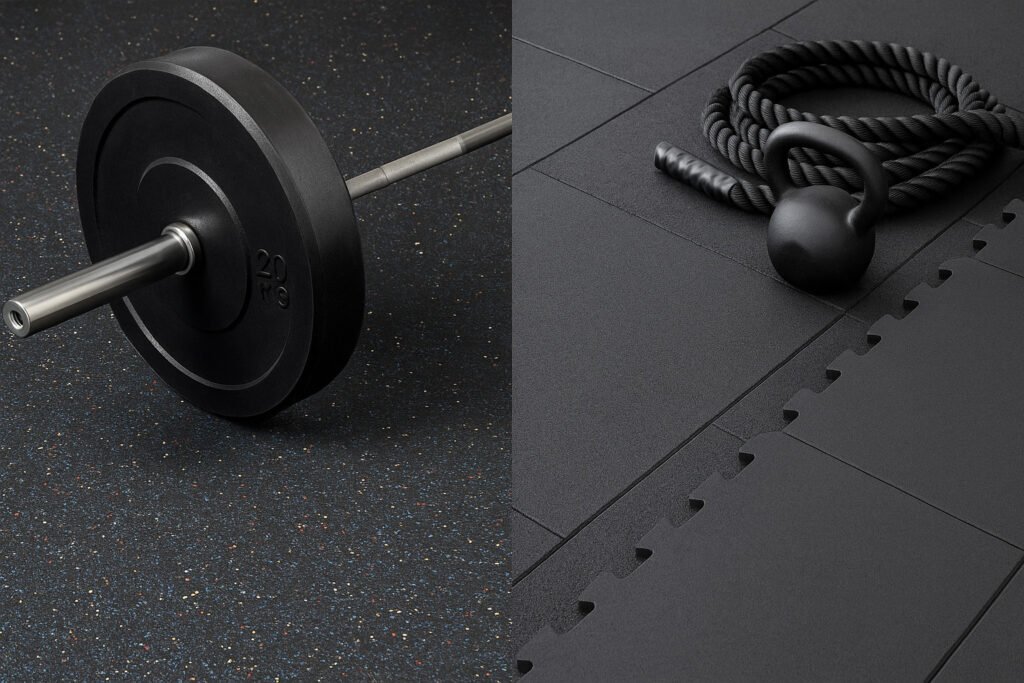Home Gym: Foam vs Rubber – Which Is Better?
Sore knees, dented floors, torn mats—bad flooring can ruin your home gym setup before you’ve even hit your stride.
Rubber flooring is more durable, safer, and better suited for high-impact workouts than foam, making it the best choice for most home gyms.

When building your home gym, the floor is often the last thing you think about—but it supports every rep, jump, and drop. Many people ask whether foam or rubber is better. I’ve tested both and supplied flooring globally, and the answer depends on your training style. Let’s break it down.
Is Rubber Better than Foam for Heavy Training?
Foam may feel soft at first, but it can’t handle weights or impact.
Rubber tiles or rolls are better than foam for weight training, HIIT, and equipment-based workouts.
Rubber flooring—especially tiny granule rubber tiles or composite rubber tiles—is designed to absorb shock and protect your subfloor. Foam mats compress or tear easily, while rubber remains stable. Clients often replace foam within months; rubber flooring lasts years.
Explore our gym rubber tile collection.
Weight Resistance Comparison
| Feature | Foam Mats | Rubber Tiles/Rolls (details) |
|---|---|---|
| Max Weight Load | ~50–70 kg | 200+ kg |
| Surface Compression | High | Low |
| Durability | Low | Very high |
| Suitable for Weights | ❌ | ✅ |
Is Foam More Comfortable for Yoga and Stretching?
Softness sounds ideal—but too soft can harm your form and stability.
Foam mats are good for yoga or bodyweight exercises if durability isn’t a priority.
Foam flooring (EVA or PE-based) is lightweight and cushions your knees but isn’t slip-resistant and wears quickly. If you mix yoga and strength training, rubber rolls provide better grip, durability, and moisture resistance.
Comfort and Control Comparison
| Feature | Foam Tiles | Rubber Rolls (details) |
|---|---|---|
| Cushioning | High | Medium |
| Stability | Low (too soft) | High |
| Slip Resistance | Medium | High |
| Ideal Use | Yoga, Light HIIT | Mixed-use zones |
Which Is Easier to Install in a Home Gym?
Installation complexity matters for home setups.
Foam tiles are easier initially, but rubber flooring is more permanent and professional.
Foam connects quickly like puzzles but shifts and peels. Rubber flooring requires adhesives or tape but stays put. We recommend interlocking puzzle rubber tiles for stability and flexibility.
View real installations in our project gallery.
Installation Comparison
| Feature | Foam Tiles | Rubber Flooring |
|---|---|---|
| Setup Time | Very fast | Moderate |
| Tools Needed | None | Utility knife |
| Floor Movement | Shifts | Stable |
| Best for Permanent Use | ❌ | ✅ |
Which Flooring Lasts Longer?
Initial savings on foam often lead to frequent replacements.
Rubber flooring outlasts foam, handles impact better, and maintains appearance.
Our products are EN1177 & CE certified for impact resistance, durability, and safety. Foam lacks these certifications and deteriorates quickly.
Longevity & Maintenance
| Feature | Foam | Rubber |
|---|---|---|
| Lifespan | 6–12 months | 5–10 years |
| Cleaning Ease | Absorbs sweat | Easy to clean |
| Looks Over Time | Fades or tears | Durable |
Can I Use Foam or Rubber Outdoors or in a Garage?
Humidity and UV rays ruin foam—but rubber thrives outdoors.
Rubber flooring suits garage gyms, basements, and outdoors due to durability and weather resistance.
Foam warps outdoors. Outdoor rubber flooring or EPDM granules are ideal for external setups, maintaining form and grip on dusty surfaces.
Conclusion
Rubber flooring is superior for most home gyms—particularly with heavy use. Foam is suitable for low-impact zones but can’t match rubber’s durability.
Explore our complete rubber flooring solutions at Lanhefloor.com.
Related Articles:
